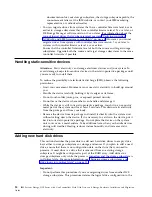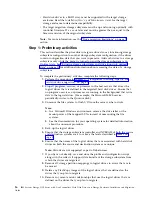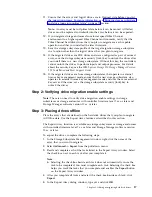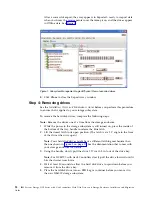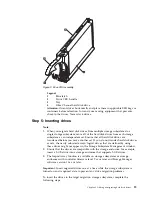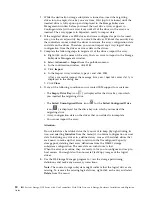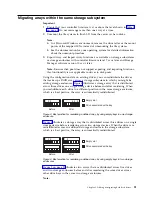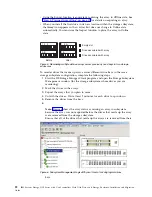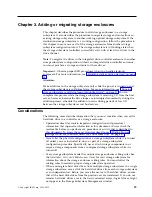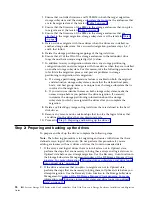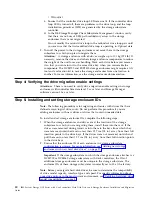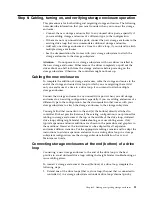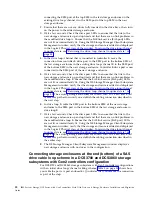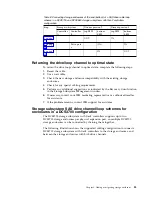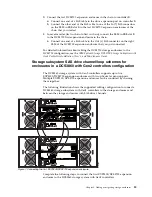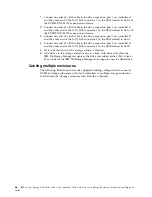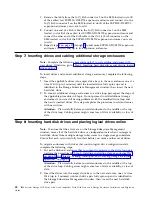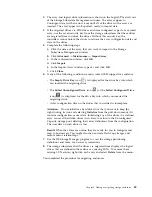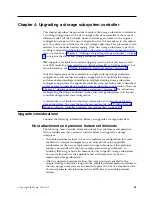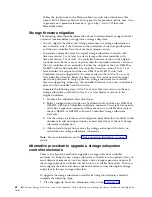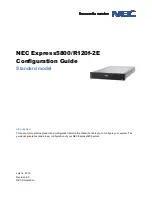
1.
Ensure that controller firmware and NVSRAM in both the target migration
storage subsystem and the storage subsystem that contains the enclosures that
are to be migrated are at the levels in Table 2 on page 5.
2.
Ensure that the firmware of the ESMs in the storage enclosures that you plan
to migrate are at the levels in Table 3 on page 5.
3.
Ensure that the firmware of the ESMs in the storage enclosures that are
attached to the target migration storage subsystem is at the levels in Table 3
on page 5.
4.
Data on drives migrate with those drives when the drives are installed on
another storage subsystem. For a successful migration, perform steps 5, 6, 7
and 8 that follow.
5.
Delete the storage partitioning mappings of the logical drives.
6.
Ensure that all of the IDs of the storage enclosures in the redundant drive
loop/channel have unique single digit (x1) values.
7.
In addition to array configuration information, any storage partitioning
configuration data on drives migrate with those drives when they are installed
on another storage subsystem. For this reason, take the following precautions
to facilitate the migration process and prevent problems in storage
partitioning configuration data migration:
a.
If a storage partitioning premium feature is enabled on both the original
and destination storage subsystems, ensure that the defined host ports,
hosts, and host group names are unique to each storage subsystem that is
involved in the migration.
b.
If you must use identical names on both storage subsystems, make the
names unique before you perform the drive migration. If necessary,
customize the storage partitioning information about the storage
subsystem to which you migrated the drives after you complete the
migration.
8.
Delete any FlashCopy images of logical drives that are defined in the hard
disk drives.
9.
Remove any remote mirror relationships that involve the logical drives that
are defined on the drives that you plan to migrate.
10.
Proceed to “Step 2: Preparing and backing up the drives.”
Step 2: Preparing and backing up the drives
To prepare and back up the drives, complete the following steps.
Note:
The following procedure is for migrating enclosures with drives that have
defined arrays/logical drives only. Do not perform this procedure if you are
adding enclosures with new drives or drives that contain unneeded data.
1.
If the arrays and logical drives that are involved are not in Optimal state,
perform the steps that are necessary to bring these arrays and logical drives to
Optimal state before you attempt migration. Use the Recovery Guru function in
the Storage Subsystem Management window of the DS Storage Manager Client
program. For more information, “Bringing storage subsystems and drive loops
into optimal state” on page 11.
2.
If the drive enclosures that you plan to migrate are not in Optimal state,
perform the steps that are necessary to bring them to Optimal state before you
attempt migration. Use the Recovery Guru function in the Storage Subsystem
Management window of the DS Storage Manager Client program. For more
information, see “Bringing storage subsystems and drive loops into optimal
state” on page 11.
28
IBM System Storage DCS Series with Gen2 controllers Hard Disk Drive and Storage Enclosure Installation and Migration
Guide
Summary of Contents for System Storage DCS Series
Page 89: ......

